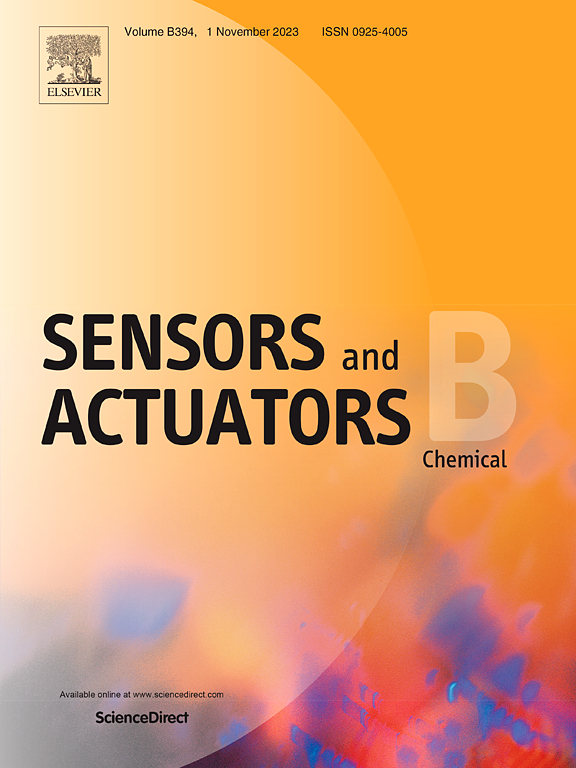A Quinolinium-Functionalized Hemicyanine Dye for Ratiometric NAD(P)H Sensing in Live Cells, Kidney Tissues, and Drosophila melanogaster
IF 8
1区 化学
Q1 CHEMISTRY, ANALYTICAL
引用次数: 0
Abstract
NAD+ (Nicotinamide adenine dinucleotide) and NADP+ (its phosphorylated variation) are key coenzymes regulating cellular metabolism, biosynthesis, and redox balance. Variations in NAD(P)H activity reflect metabolic activity and are associated with diseases like cancer, metabolic disorders, and neurodegeneration. Live tracking of NAD(P)H is important for comprehending these processes and their dysregulation in disease. However, existing ratiometric emission sensors are hindered by spectral interference from NADH emission, limiting their sensitivity and accuracy in complex biological systems. We present a ratiometric emission sensor based on a 3-quinolinium-hemicyanine dye with amine linkage, designed to address these limitations. By using a longer excitation wavelength (470 nm), the sensor avoids interference from NADH emission, enabling precise monitoring of NAD(P)H activity. Binding to NAD(P)H triggers a photo-induced electron transfer (PET) mechanism, resulting in an increase in visible emission at 519 nm and subtle reduction in near-infrared emission at 711 nm, providing a clear ratiometric signal. We demonstrate the sensor’s effectiveness in live cells, tissues, and whole organisms. In HeLa cells, exposure to glucose, maltose, fludarabine or cisplatin induced dose-dependent ratiometric emission changes, reflecting metabolic shifts and oxidative stress. The sensor also successfully detected NAD(P)H fluctuations in Drosophila melanogaster larvae and mammalian kidney tissues, including disease models like ADPKD (autosomal dominant polycystic kidney disease). Importantly, the sensor can distinguish NAD(P)H dynamics from high NADH levels, overcoming a key limitation of current sensors. Co-localization with a mitochondrial dye confirmed the sensor’s selective targeting to mitochondria, highlighting its suitability for studying Mitochondrial energy processes and redox changes. This ratiometric sensor provides a sensitive, interference-free tool for live tracking of NAD(P)H kinetics in complex biological systems. Its high sensitivity, accuracy, and versatility offer new opportunities for investigating cellular metabolism, disease mechanisms, and therapeutic interventions in both cellular and in vivo models.

喹啉功能化半花青碱染料在活细胞、肾组织和黑腹果蝇中的比例NAD(P)H感应
NAD+(烟酰胺腺嘌呤二核苷酸)和NADP+(其磷酸化变异)是调节细胞代谢、生物合成和氧化还原平衡的关键辅酶。NAD(P)H活性的变化反映了代谢活动,并与癌症、代谢紊乱和神经变性等疾病有关。实时跟踪NAD(P)H对于理解这些过程及其在疾病中的失调具有重要意义。然而,现有的比例发射传感器受到NADH发射光谱干扰的阻碍,限制了它们在复杂生物系统中的灵敏度和准确性。我们提出了一种基于胺连接的3-喹啉半菁染料的比例发射传感器,旨在解决这些限制。通过使用较长的激发波长(470 nm),该传感器避免了NADH发射的干扰,从而能够精确监测NAD(P)H活性。与NAD(P)H结合触发光诱导电子转移(PET)机制,导致519 nm处可见光发射增加,711 nm处近红外发射略有减少,提供清晰的比率信号。我们演示了传感器在活细胞、组织和整个生物体中的有效性。在HeLa细胞中,暴露于葡萄糖、麦芽糖、氟达拉滨或顺铂诱导剂量依赖性比值发射变化,反映代谢变化和氧化应激。该传感器还成功检测到黑腹果蝇幼虫和哺乳动物肾脏组织中NAD(P)H的波动,包括ADPKD(常染色体显性多囊肾病)等疾病模型。重要的是,该传感器可以区分NAD(P)H动态和高NADH水平,克服了当前传感器的一个关键限制。与线粒体染料的共定位证实了该传感器对线粒体的选择性靶向,突出了其在研究线粒体能量过程和氧化还原变化方面的适用性。这种比例传感器为复杂生物系统中NAD(P)H动力学的实时跟踪提供了一种灵敏、无干扰的工具。它的高灵敏度、准确性和多功能性为研究细胞代谢、疾病机制以及细胞和体内模型的治疗干预提供了新的机会。
本文章由计算机程序翻译,如有差异,请以英文原文为准。
求助全文
约1分钟内获得全文
求助全文
来源期刊

Sensors and Actuators B: Chemical
工程技术-电化学
CiteScore
14.60
自引率
11.90%
发文量
1776
审稿时长
3.2 months
期刊介绍:
Sensors & Actuators, B: Chemical is an international journal focused on the research and development of chemical transducers. It covers chemical sensors and biosensors, chemical actuators, and analytical microsystems. The journal is interdisciplinary, aiming to publish original works showcasing substantial advancements beyond the current state of the art in these fields, with practical applicability to solving meaningful analytical problems. Review articles are accepted by invitation from an Editor of the journal.
 求助内容:
求助内容: 应助结果提醒方式:
应助结果提醒方式:


